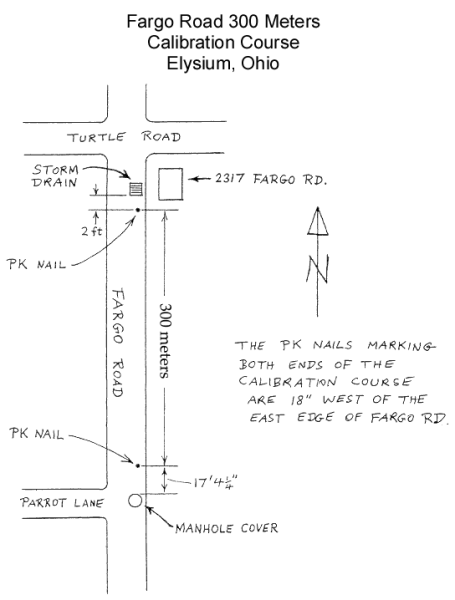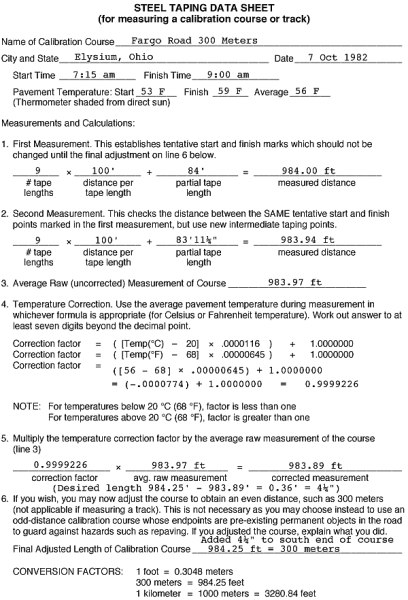
APPENDIX C - Example of Course Measurement
Setting Up the Calibration Course
It is 7:15 a.m. on 7 October 1982 in Elysium, OH. You arrive at your pre-selected site for the calibration course on Fargo Road with your two trusty helpers, Ralph Doe and Susan Marker. This section of Fargo Road is straight and level, recently paved, with no cross-traffic and little traffic of any kind. You have checked your equipment list and everything is accounted for.
You have decided to set up a 300 meter calibration course, which will be convenient for measuring metric race courses (and you are, in fact, planning to measure a 10 kilometer race course). You couldn’t find a metric tape in your local hardware store so you are using a 100-foot tape instead. Since 300 meters = 984.25 feet, you will be laying out 9 and a fraction lengths of the 100-foot tape.
[Note: You probably can find a metric tape by checking stores that sell to the surveying profession, companies that sell equipment for track meets, educational supply houses, or by visiting any hardware store outside the United States.]
Locate the start. There is a storm drain just south of the intersection of Fargo Road with Turtle Road. This will make a nice permanent reference. You drive a PK nail into the pavement, 18 inches west of the east edge of Fargo Road and exactly 2.0 feet south of the south edge of the storm drain located in front of 2317 Fargo Road. This will be the permanent northern endpoint of your calibration course (point A).
You lay the thermometer on the pavement, standing so that you shade the thermometer. After three minutes, the temperature seems to have stopped changing. It reads 53 °F. Susan records the start time and temperature.
Ralph holds the 100 ft mark of the tape over the PK nail at point A. You grab the “zero” end and extend the tape (southward) while walking it out to its full extension of 100 feet. You are using the zero end because that is the end with a ring to which you can attach a spring balance. You and Ralph jiggle the tape as needed until it lies straight and flat, and you check that your end is still 18 inches from the curb. Then you start pulling on the spring balance until it reaches 50 newtons (5 kilograms-force, or 11 pounds-force), moving the tape slowly forward.
In the meantime, Susan tears off a piece of masking tape (which she has already pre-numbered with numeral “1”) from her roll and sticks it on the roadway at your end of the tape. When you have the tape steadily under tension and Ralph signals that his end is over the mark, Susan puts a thin black mark on the masking tape alongside the zero mark of the measuring tape.
You continue in this manner until you have marked 9 one-hundred-foot sections. At this point, you mark an 84-foot section. The procedure is exactly as before except that Ralph uses the 84-foot mark instead of the 100-foot mark on the tape. You still pull the spring balance with the full force of 50 newtons (do not use less force, even though you’re using a smaller portion of the tape). The marked point (point “B”) is now 984 feet south of point A. It isn't necessary to get exactly 984.25 feet at this step since a final adjustment will be made later. Susan enters 9 tape lengths × 100 feet each, with a “partial” tape length of 84 feet.
You now start measuring back (northward) from point B, in 100-foot lengths, using new pieces of masking tape which will each be intermediate to the previous marks. You use a red pen this time, to clearly distinguish these marks from the old ones. Note that you had to turn the tape around at point B since only the zero end has a ring where you can attach the spring balance.
As before, you lay out 9 full 100-foot tape lengths. However, you measure the last interval to the PK nail at point A. This is found to be 83 feet 11¼ inches. Thus, according to your second measurement, the distance between the permanently marked point A and your temporary point B is ¾ inch short of 984 feet. The second measurement is 983 feet 11¼ inches or 983.94 feet in decimal form.
You repeat the temperature reading as before and find it to be 59 °F. Susan records this datum.
You now calculate the temperature-corrected average measured distance between points A and B, as instructed on the Steel Taping Data Sheet. The corrected measurement is 983.89 feet. Since your desired calibration course length is 300 meters or 984.25 feet, you must now lengthen the tentative course by 0.36 feet which is equal to 4¼ inches. You do this by moving point B to a point 4¼ inches further south. Using the tape measure once more, you find that the corrected point B is 17 ft 4¼ inches north of the north edge of the manhole in the center of the intersection of Fargo Road and Parrot Lane.
You are now almost finished. But, before permanently marking point B, you check to make sure you haven’t missed a whole tape length somehow. You take your bicycle off of the rack and ride it around for a few minutes to warm up the tires. You place the bicycle’s front axle over the north endpoint and record a count of 12546. You then ride southward one 100 foot tape length (being careful to use a 100 ft interval rather than the 84 ft interval!), and stop with the front axle over the mark. You record a count of 12833. The difference, corresponding to one tape length, is 287 counts.
You now return to the northern endpoint (point A) and, pointing the bike southward again, note a counter reading of 13217 with the front axle over the mark. You ride the bicycle over the full calibration course, stopping with the front axle over the corrected southern endpoint. You record a count of 16036. The difference is 2819 counts. Dividing the full course count of 2819 by the 100 ft count of 287 yields a course length of 9.82 tape lengths which, for such a rough check, is in excellent agreement with the intended course length of 9.8425 tape lengths.
Finally, you put a PK nail at the corrected endpoint (point B) of your 300 meter course. You thank Ralph and Susan and head home to fill out the forms necessary to obtain certification of your new calibration course.



| Go to Next Section: | Appendix C - Example - Calibrating the Bicycle |
| Previous Section: | Appendix B - Course Layout |
| Back to: | Table of Contents |